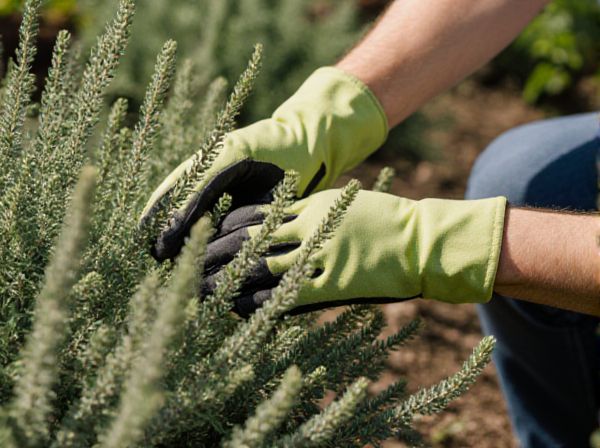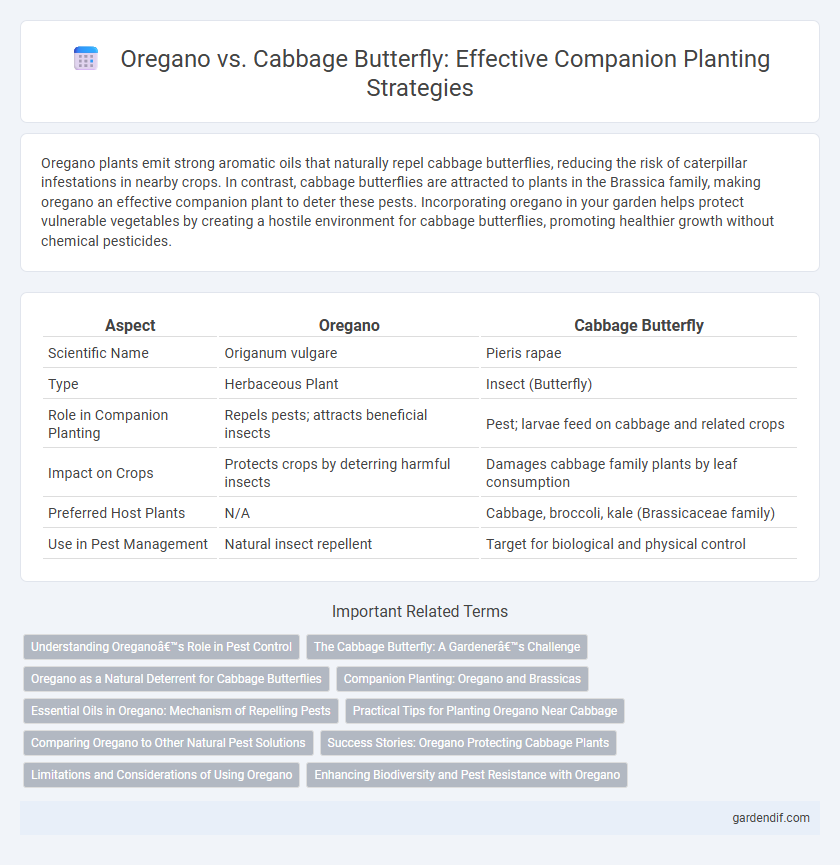
Oregano vs cabbage butterfly Illustration
Oregano plants emit strong aromatic oils that naturally repel cabbage butterflies, reducing the risk of caterpillar infestations in nearby crops. In contrast, cabbage butterflies are attracted to plants in the Brassica family, making oregano an effective companion plant to deter these pests. Incorporating oregano in your garden helps protect vulnerable vegetables by creating a hostile environment for cabbage butterflies, promoting healthier growth without chemical pesticides.
Table of Comparison
| Aspect | Oregano | Cabbage Butterfly |
|---|---|---|
| Scientific Name | Origanum vulgare | Pieris rapae |
| Type | Herbaceous Plant | Insect (Butterfly) |
| Role in Companion Planting | Repels pests; attracts beneficial insects | Pest; larvae feed on cabbage and related crops |
| Impact on Crops | Protects crops by deterring harmful insects | Damages cabbage family plants by leaf consumption |
| Preferred Host Plants | N/A | Cabbage, broccoli, kale (Brassicaceae family) |
| Use in Pest Management | Natural insect repellent | Target for biological and physical control |
Understanding Oregano’s Role in Pest Control
Oregano acts as a natural repellent against cabbage butterflies, disrupting their ability to locate and infest cabbage crops. The strong aromatic compounds in oregano emit volatile oils that deter cabbage butterfly larvae, reducing their population and damage in gardens. Integrating oregano as a companion plant enhances pest management by exploiting its bioactive properties to protect vulnerable plants without chemical pesticides.
The Cabbage Butterfly: A Gardener’s Challenge
The cabbage butterfly, scientifically known as Pieris rapae, poses a significant threat to gardeners by targeting brassica plants such as cabbage, kale, and broccoli. Its larvae voraciously consume leaves, causing extensive damage that can stunt plant growth and reduce yields. Effective companion planting with oregano can help repel cabbage butterflies, due to oregano's strong aromatic oils deterring these pests naturally.
Oregano as a Natural Deterrent for Cabbage Butterflies
Oregano acts as a natural deterrent for cabbage butterflies, emitting strong aromatic compounds that repel these pests and protect cabbage plants. Its essential oils contain carvacrol and thymol, which interfere with the butterflies' ability to locate host plants for egg-laying. Integrating oregano in companion planting enhances pest management without harmful chemicals, supporting a healthier garden ecosystem.
Companion Planting: Oregano and Brassicas
Oregano serves as an effective companion plant for Brassicas by repelling cabbage butterflies, which are common pests targeting Brassica crops such as cabbage, broccoli, and kale. The strong aromatic oils in oregano mask the scent of Brassicas, reducing egg-laying by cabbage butterflies and minimizing larval damage. Integrating oregano within Brassica gardens promotes natural pest control, enhancing plant health and increasing overall yield without relying on chemical pesticides.
Essential Oils in Oregano: Mechanism of Repelling Pests
Oregano essential oils, rich in carvacrol and thymol, disrupt the olfactory receptors of cabbage butterflies, effectively repelling them from host plants. These bioactive compounds interfere with the pest's sensory cues, reducing egg-laying and larval infestation on cabbage crops. Integrating oregano as a companion plant leverages its essential oil's natural pest-repellent properties, enhancing sustainable pest management in vegetable gardens.
Practical Tips for Planting Oregano Near Cabbage
Plant oregano near cabbage to naturally repel cabbage butterflies, which helps reduce pest damage and enhances cabbage growth. Space oregano plants 12 to 18 inches apart around cabbage beds to maximize airflow and aromatic barrier effects. Regularly prune oregano to encourage bushier growth and maintain its effectiveness as a companion plant in pest control.
Comparing Oregano to Other Natural Pest Solutions
Oregano offers a potent natural defense against cabbage butterflies, containing essential oils that repel larvae and reduce plant damage more effectively than many herbs. Compared to other natural pest solutions like neem or garlic, oregano is favored for its dual role as both a culinary herb and an insect deterrent, enhancing garden biodiversity without harsh chemicals. Its compact growth and aromatic foliage create an inviting environment for beneficial insects while minimizing pest infestations on nearby cabbage crops.
Success Stories: Oregano Protecting Cabbage Plants
Oregano acts as an effective natural repellent against cabbage butterflies, significantly reducing egg-laying on cabbage plants and decreasing larval damage. In numerous companion planting success stories, oregano's strong aroma masks cabbage's scent, preventing cabbage butterflies from locating their preferred host. Gardeners report healthier cabbage crops and reduced need for chemical pesticides when oregano is strategically planted near cabbage beds.
Limitations and Considerations of Using Oregano
Oregano, while effective as a natural repellent for cabbage butterflies, has limitations including its variable potency depending on growth conditions and concentration used. It may not provide complete protection for large-scale crops and requires frequent application to maintain efficacy. Consideration should be given to potential impacts on beneficial insects and the need to integrate oregano with other pest management strategies for optimal control.
Enhancing Biodiversity and Pest Resistance with Oregano
Oregano acts as an effective companion plant by attracting beneficial insects that prey on cabbage butterfly larvae, thereby enhancing pest resistance in cruciferous crops. Its strong aromatic oils repel cabbage butterflies, reducing egg-laying and subsequent larval damage on cabbage and related plants. Incorporating oregano alongside cabbage fosters biodiversity, promoting a balanced ecosystem that supports natural pest control and healthier crop yields.
Oregano vs cabbage butterfly Infographic

 gardendif.com
gardendif.com